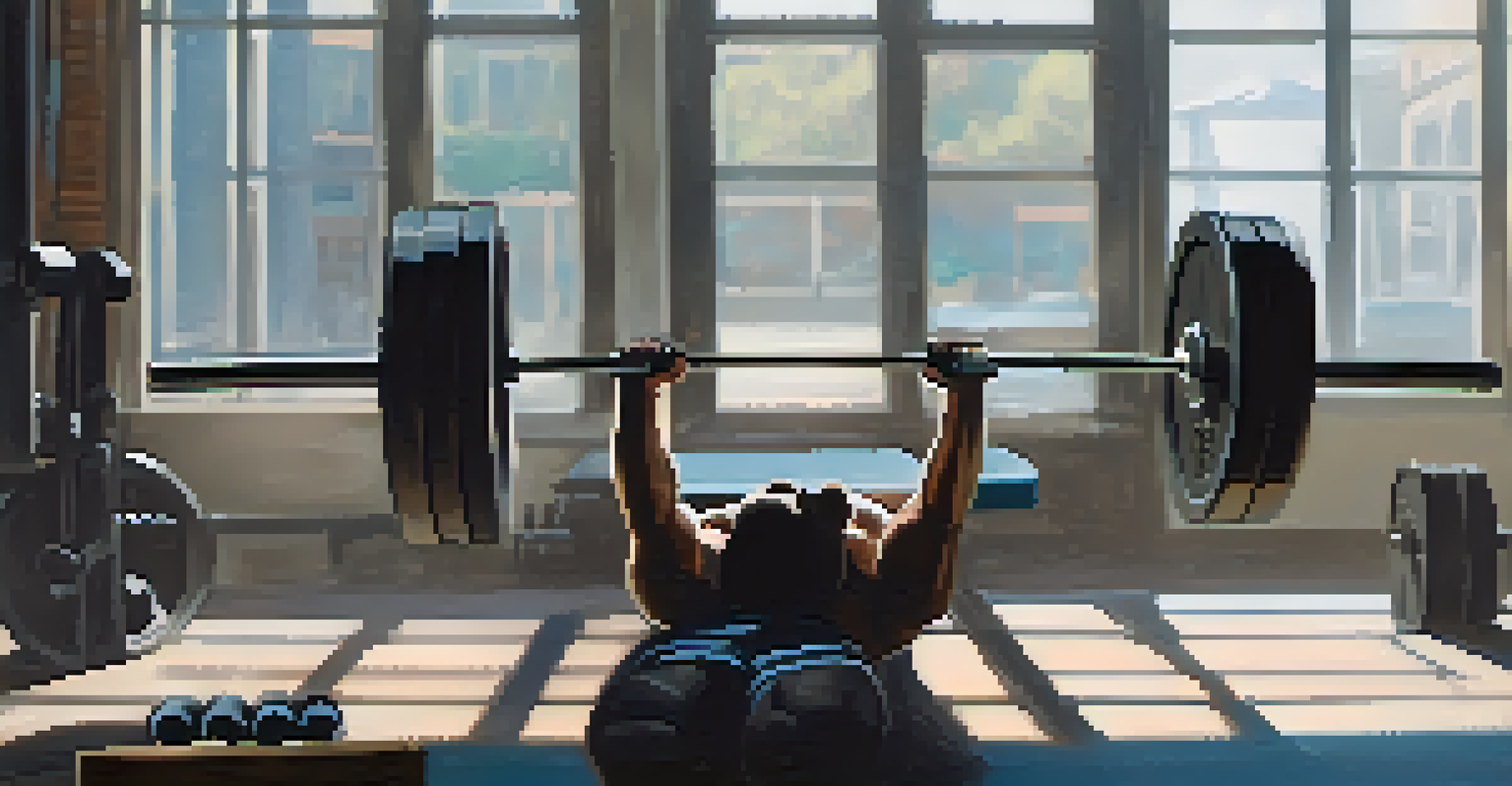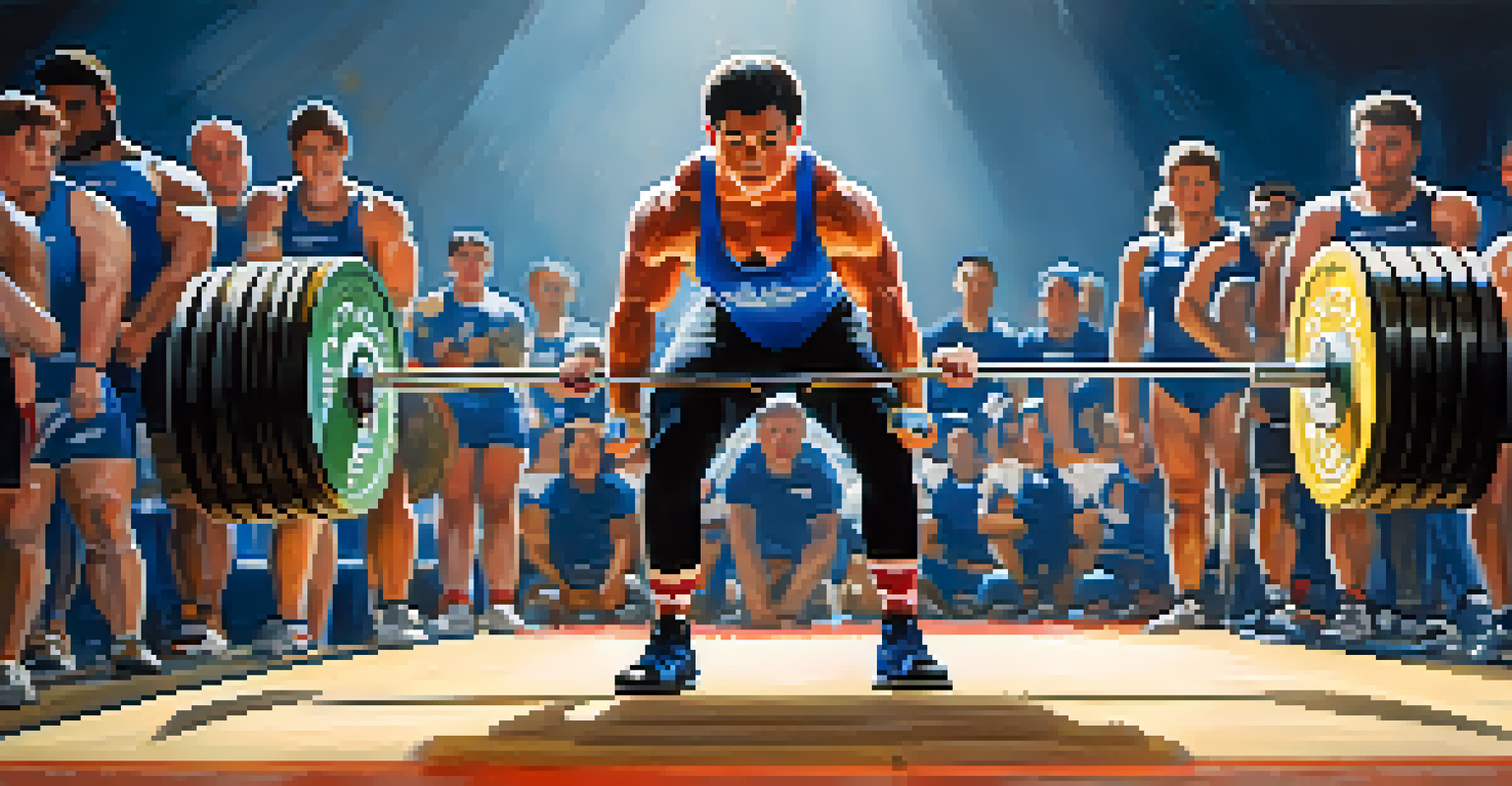Understanding Powerlifting: Techniques and Training Methods

What is Powerlifting and Its Core Lifts?
Powerlifting is a strength sport that focuses on three main lifts: the squat, bench press, and deadlift. Each lift tests different muscle groups and overall strength, making powerlifting a comprehensive way to build muscle and power. Athletes compete to lift the maximum weight possible in each of these lifts, often in a competitive setting.
Strength does not come from physical capacity. It comes from an indomitable will.
The squat emphasizes leg strength and technique, requiring a balance of flexibility and power. The bench press targets the upper body, specifically the chest, triceps, and shoulders. Lastly, the deadlift is a full-body movement that showcases the strength of the posterior chain, including the back and hamstrings.
Understanding these core lifts is crucial for anyone looking to enter the world of powerlifting. Each lift not only builds strength but also enhances athletic performance and functional fitness.
The Importance of Proper Technique in Powerlifting
Technique is everything in powerlifting; it's what separates a good lifter from a great one. Proper form helps prevent injuries and ensures that you’re lifting efficiently. Each lift has specific cues that, when followed, maximize your strength output and minimize the risk of injury.

For example, in the squat, maintaining a neutral spine and proper knee alignment is essential. In the bench press, controlling the bar's descent while keeping your elbows tucked can make a significant difference. Likewise, in the deadlift, engaging your core and keeping the bar close to your body are key to a successful lift.
Core Lifts Define Powerlifting
Powerlifting centers around three key lifts: squat, bench press, and deadlift, which collectively build overall strength and muscle.
Investing time in mastering your technique pays off in the long run. Not only will it help you lift heavier weights, but it will also make your training sessions more enjoyable and effective.
Developing a Training Program for Powerlifting
Creating a powerlifting training program involves balancing volume, intensity, and frequency tailored to your goals. Beginners often benefit from a linear progression model, where weights gradually increase each week. More advanced lifters may employ periodization, cycling through phases of volume and intensity to peak for competitions.
The difference between a successful person and others is not a lack of strength, not a lack of knowledge, but rather a lack in will.
In addition to the main lifts, accessory exercises play a crucial role in building strength and addressing weaknesses. Movements like overhead presses, rows, and lunges can enhance your overall performance. Incorporating these variations helps develop supporting muscles that contribute to your main lifts.
Tracking your progress in a structured program can lead to significant strength gains. Regularly assessing your lifts and making adjustments helps keep your training effective and aligned with your goals.
Nutrition's Role in Powerlifting Success
Nutrition is a vital component of any powerlifting program. Fueling your body with the right nutrients can enhance performance and recovery. A balanced diet rich in protein, complex carbohydrates, and healthy fats provides the energy needed for intense training sessions.
Protein is particularly important for muscle repair and growth, so aim for a sufficient intake based on your body weight and activity level. Carbohydrates serve as your primary energy source, especially during heavy lifting days. Incorporating nutrient-dense foods will support your overall health and performance.
Technique is Crucial for Success
Proper technique not only enhances lifting efficiency but also significantly reduces the risk of injury across all powerlifting movements.
Don’t overlook hydration, as it plays a crucial role in maintaining strength and endurance. Staying properly hydrated can prevent fatigue and help your body recover more effectively between workouts.
The Mental Aspect of Powerlifting Training
Powerlifting isn’t just a physical challenge; it’s a mental one too. Developing mental toughness is essential for pushing through tough workouts and dealing with setbacks. Visualization techniques and positive self-talk can enhance your focus and confidence during lifts.
Setting specific, achievable goals can also help maintain motivation. Whether it’s hitting a certain weight or mastering a lift, having clear objectives keeps you focused. Celebrating small victories along the way can boost your morale and drive.
Moreover, surrounding yourself with a supportive community can make a huge difference. Engaging with fellow lifters, whether in person or online, provides encouragement and valuable insights that can enhance your journey.
Common Mistakes to Avoid in Powerlifting
Like any sport, powerlifting has its share of common pitfalls that can hinder progress. One major mistake is neglecting proper warm-ups and mobility work. Skipping these can lead to injuries and limit your performance during heavy lifts.
Another frequent error is focusing solely on the main lifts while ignoring accessory work. Accessory exercises are crucial for building strength and addressing imbalances, so don’t overlook them in your training. Additionally, rushing through workouts can lead to poor form and increased risk of injury.
Nutrition Supports Performance
A balanced diet rich in protein, carbohydrates, and healthy fats is essential for optimal energy, recovery, and overall success in powerlifting.
Finally, be cautious of overtraining. It’s essential to listen to your body and incorporate rest days into your routine. Understanding when to push hard and when to recover is key to long-term success in powerlifting.
Preparing for a Powerlifting Competition
Preparing for a powerlifting competition requires careful planning and strategy. Start by establishing a peaking phase in your program, where you gradually taper your training volume while increasing intensity. This ensures that you’re at your strongest on competition day.
It's also vital to familiarize yourself with the rules and regulations of the competition. Understanding the commands for each lift and how the scoring system works will help you perform better. Practice your lifts under competition conditions to build confidence.

Lastly, don’t forget about the logistics of the day itself. Plan your nutrition, hydration, and warm-up routines ahead of time to minimize stress. Being prepared will allow you to focus on executing your lifts and achieving your goals.